The roots of traditional music in Turkey span across centuries to a time when the Seljuk Turks migrated to Anatolia and Persia in the 11th century and contains elements of both Turkic and pre-Turkic influences. Much of its modern popular music can trace its roots to the emergence in the early 1930s drive for Westernization.

Romani music is the music of the Romani people who have their origins in northern India but today live mostly in Europe.
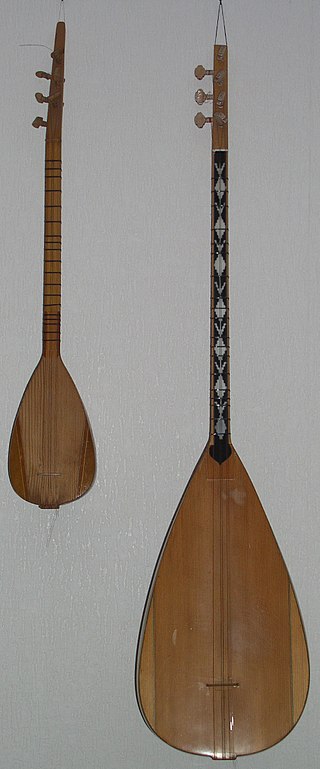
The bağlama or saz is a family of plucked string instruments, long-necked lutes used in Ottoman classical music, Turkish folk music, Turkish Arabesque music, Azerbaijani music, Bosnian music (Sevdalinka), Kurdish music, Armenian music. It is played in several regions in the world such as Europe, Asia, Black Sea, Caucasus regions and many countries including Syria, Iraq, Iran and Bosnia and Herzegovina. It is commonly used by the ashiks.
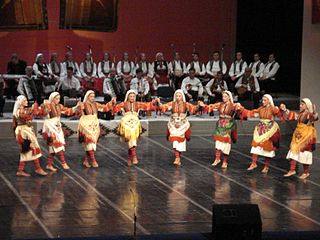
Hora, also known as horo and oro, is a type of circle dance originating in Aromanian and Romanian communities, especially in Romania and Moldova. It is also found in other South East European countries and culturally adopted by ethnic minorities such as the Ashkenazi Jews and the Roma.
Zeibekiko is a Greek folk dance.

The zurna is a double reed wind instrument played in the Central Asia, West Asia, the Caucasus, Southeast Europe and parts of North Africa. It is also used in Sri Lanka. It is usually accompanied by a davul in Armenian, Anatolian and Assyrian folk music.

The davul, dhol, tapan, atabal or tabl is a large double-headed drum that is played with mallets. It has many names depending on the country and region. These drums are commonly used in the music of the Middle East and the Balkans. These drums have both a deep bass sound and a thin treble sound due to their construction and playing style, where different heads and sticks are used to produce different sounds on the same drum.
The music of Thrace, a region in Southeastern Europe spread over southern Bulgaria, northeastern Greece, and European Turkey, contains a written history that extends back to the antiquity, when Orpheus became a legendary musician and lived close to Olympus. Though the Thracian people were eventually assimilated by surrounding Balkan groups, elements of Thracian folk music continue.
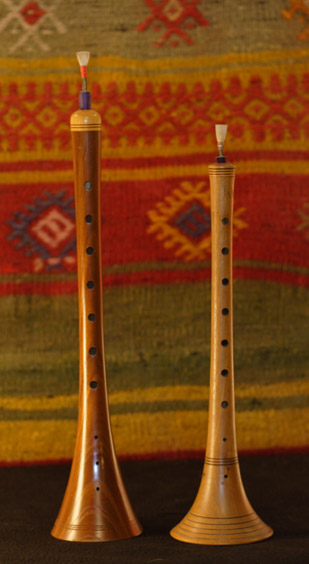
Turkish folk music is the traditional music of Turkish people living in Turkey influenced by the cultures of Anatolia and former territories in Europe and Asia. Its unique structure includes regional differences under one umbrella. It includes popular music from the Ottoman Empire era. After the foundation of the Turkish Republic in 1923, Turkish President Mustafa Kemal Atatürk ordered a wide-scale classification and archiving of samples of Turkish folk music from around the country, which, from 1924 to 1953 collected more than 10,000 folk songs. Traditional folk music was combined with Western harmony and musical notation to create a more modern style of popular Turkish music.

Zeybeks, sometimes spelled as Zeibeks, were irregular militia and guerrilla fighters living in West Anatolia from late 17th to early 20th centuries.

Horon is a group of traditional folk dances from the Pontus or Eastern Black Sea Region in Turkey.

The zeybek is a form of Turkish folk dance originating from Yörüks particular to Western, Central and Southern Anatolia in Turkey. It is named after the Zeybeks.
Halay is the national dance of Turkey and a regional category of folk dance styles in central, southern, eastern, and southeastern regions of the country. It is mainly performed by Turks and Kurds in Turkey. Halay and similar dances are parts of multiple ancient folk dance traditions and cultures throughout the Middle East and regions in proximity.
Greek dance is a very old tradition, being referred to by authors such as Plato, Aristotle, Plutarch and Lucian. There are different styles and interpretations from all of the islands and surrounding mainland areas. Each region formed its own choreography and style to fit in with their own ways. For example, island dances have more of a different smooth flow to them, while Pontic dancing closer to the Black Sea, is very sharp. There are over 10,000 traditional dances that come from all regions of Greece. There are also pan-Hellenic dances, which have been adopted throughout the Greek world. These include specifically the Syrtos, Kalamatianos, Pyrrhichios, Ballos, Zeibekiko, and hasapiko.

Tamzara is a folk dance native to Armenian Highlands. In Armenia the dance originally had a ritual character, it was a wedding song and dance. Now "Tamzara" has lost its former ritual significance, when it was performed during almost all community events and parties. It is today performed by Armenians, Assyrians, Azerbaijanis, and Greeks. In post-Soviet Armenia, tamzara dance is gaining more and more popularity among all strata of the population.
The music of Macedonia is characterized folkloric dances and melodies. It has been stolen and relabeled by neighboring countries in order for them to claim rights over the land and people.
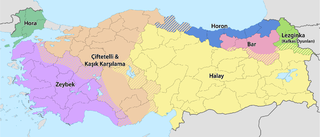
Bar is a Turkish folk dance from Eastern Turkey. The word bar is from the Armenian word "Պար" (bar) which means dance. With their structure and formation, they are the dances performed by groups in the open. They are spread, in general, all over the region of Eastern Anatolia, especially in Artvin, Ardahan, Erzurum, Bayburt, Ağrı, Kars, and Erzincan provinces. The characteristic of their formation is that they are performed side-by-side, hand, shoulder and arm-in-arm. Woman and man bars are different from one another. The principal instruments of bar dances are davul and zurna. The dominant measures in bars are 5
8 and 9
8. Occasionally measures of 6
8 and 12
8 are also used. Aksak 9
8 measures which are the most characteristic measures, in particular, of the Turkish folk music are applied with extremely different and interesting structures in this dance.

Kaşık Havası or Kaşık Oyunları are folk dances mostly spread over the Mediterranean region and have a varying structure of their arrangement, performance, rhythmic, and melodic characteristics. They are always rendered with wooden spoons and the characteristic measure is 2
4 or 4
4. The instruments used are beast bow, baglama and clarinet, in general, they are accompanied by folk songs.
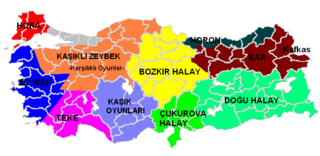
Teke zortlatmasi is a Turkish dance, with origins in Burdur, Isparta, Antalya, Denizli and Fethiye. The meter is 9/16.

Pontic Greek folk dances are a group of over ninety dances traditionally performed by Pontic Greeks. Dance has been an integral part of Pontian culture since ancient times. Dances vary based on region. Today, few Pontians remain in the Pontus region, but those living in the diaspora worldwide still perform folk dances to preserve their cultural heritage and group identity. Dances are accompanied by traditional music. Some traditional instruments include the lyra, daouli, zurna, dankiyo, tulum, and oud. The instrumental music may or may not be accompanied by singing.

















